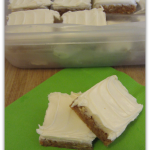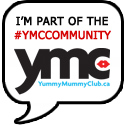Living Green – Tips
# 1 -
When you purchase your next computer, consider buying a laptop –
When plugged in your laptop uses 50 percent less energy than a typical desktop computer and a whooping 99 percent less when running on battery power!! That’s a HUGE energy saving!!
# 2-
Wear it or use it more than once -
OK…I’m not talking about your underwear and socks, but there are many items of clothing we just automatically remove and toss in the laundry. (Personally, I wish I could wear my jeans for a couple weeks before I had to wash them!!) And what about those big fluffy bath towels….hang them on a hook…they don’t need to be tossed after every use.
#3 -
Plant a Tree or Two or Three
Most of us know that planting trees can help the environment. Trees trap CO2 emissions, minimizing the effects of global warming.
Did you know they also have many other beneficial effects such as:
- cooling your home
- capturing dust particles from the air
- reducing noise pollution
- imparting beauty and serenity
- stabilizing soil and preventing runoff
- harbouring wildlife
- providing a windbreak
- increased property values
- providing exercise opportunities such as raking up fallen leaves or mulching fallen bark (Red Nomad OZ)
- Saving money – planting evergreens this summer in hopes to have Christmas trees in several years ( Tricia )
- yummy jelly made from our flowering crabapple trees, and we just planted some eating apple trees (Oak Lawn Lady )
- some trees (like the camphor and neem trees) can be used for medicinal purposes, too (Picture Clusters)
- being surrounded by plants makes us feel relaxed and good about ourselves (My bric-a-brac )
- Provides shade for humans and animals on a hot Summers day (Oak Lawn Lady)
- A large Oak or Maple is a good place to plant a small shade garden (Oak Lawn Lady)
- Experimenting with trees in pots as well as planted in the yard. It has been so relaxing to fuss over them! (Not Just Another Mother Blogger!)
- Our trees came in useful today for my daughter’s science project – she had to draw and identify trees and plants in our garden! So trees are also an educational tool!! (Jill )
- A big old oak tree in your back yard is the perfect setting for a July wedding!!! (Oak Lawn Lady)
# 4 – Reduce-Reuse-Recycle
Part 1 – Reduce
The critical first step of waste prevention has been overshadowed by a focus on recycling. Please help to promote a greater awareness of the importance of the “Reduce” part of the Reduce-Reuse-Recycle mantra.
- Simplify: Simplify your life as much as possible. Only keep belongings that you use/enjoy on a regular basis. By making the effort to reduce what you own, you will naturally purchase less/create less waste in the future.
- Reduce Purchases: In general, think before you buy any product – do you really need it? How did the production of this product impact the environment and what further impacts will there be with the disposal of the product (and associated packaging materials)?
- Replace Disposables: Wherever possible, replace disposable products with reusable ones (i.e., razor, food storage, batteries, ink cartridges (buy refill ink), coffee filters, furnace or air conditioner filters, etc.).
- Buy Used: Buy used products whenever possible. Some sources:
– local thrift stores
– Kijiji http://www.kijiji.ca/
– eBay http://www.ebay.ca/
– Craigslist http://geo.craigslist.org/iso/ca
– Amazon http://www.amazon.ca/
– Freecycle http://www.freecycle.org/
– local newspaper listings
– local garage sales
– local used furniture stores
– local consignment stores
- Borrow From Friends: If you only need something temporarily, ask if a friend or neighbour would loan it to you.
- Share With Friends: Share things like books, magazines, movies, games, and newspapers between friends and neighbours.
…There is a lot of information on this topic and the post is getting very long, so I’ll continue it next Saturday!!
Much of the information contained in this post was obtained, with permission, from the following site –
http://www.globalstewards.org/ecotips.htm#reduce
# 4
Reduce-Reuse-Recycle
Part 1 – Reduce
-
As much as possible, create a tree-free home:
- replace paper napkins with cloth napkins
- replace paper towels with a special set of cloth towels or cut up old t-shirts for great towels and just wash and reuse
- purchase bleach-free, toilet paper that is made from the highest post-consumer waste content you can find (80% minimum)
- if you print documents, print on once-used paper and/or bleach-free, recycled paper with the highest post-consumer waste content available (or hemp/alternative-source paper, if you can afford it)
- reuse envelopes, wrapping paper, the front of gift cards (as postcards) and other paper materials you receive wherever possible
- read books, magazines, and newspapers from your local library
- create and use note pads from once-used paper
- leave messages for family members/roommates on a reusable message board
- make your own cards/letters from once-used products or handmade paper
- if you will be doing construction on your house, search out alternatives to using newly cut wood
-
Bulk Purchases: Avoid products that are packaged for single use (i.e., drinks, school lunches, candy, cat and dog food, salad mixings, etc.). Instead, buy in bulk and transfer the products to your own reusable containers. Many health food stores have bulk bins where they sell everything from grains to cereal to cleaning products. For additional ideas, read this Precycling information page.
-
Buy Only What You Need: Buy only as much as you know you’ll use for items such as food, cleaning supplies, and paint.
-
Avoid Creating Trash: Avoid creating trash wherever possible: when ordering food, avoid receiving any unnecessary plastic utensils, straws, etc. (ask in advance), buy ice cream in a cone instead of a cup, don’t accept “free” promotional products, buy products with the least amount of packaging, etc. Every little bit of trash avoided does make a difference!
-
Shopping Bags: While shopping, if you only buy a few products skip the shopping bag. For larger purchases, bring your own. Learn about the dangers of plastic bags and what countries around world are doing about it
-
Junk Mail: For ideas on how to reduce junk mail, check out Do-it-yourself: Stop junk mail, email and phone calls
-
Mug-to-Go: Carry a mug with you wherever you go for take out beverages
-
Waste-Free Lunches: Pack a Waste-Free Lunch whenever possible.
-
Encourage Hotels to Reduce Waste: When staying at a hotel, motel, or bed and breakfast let the management know that you like to support businesses that adopt environmentally responsible practices (including reducing waste) and/or visit Green Hotels Association
The information contained in this post was obtained, with permission, from the following site – http://www.globalstewards.org/ecotips.htm#reduce
#5 EARTH HOUR 2011 -
It’s time to go beyond the hour

“Earth Hour started in 2007 in Sydney, Australia when 2.2 million individuals and more than 2,000 businesses turned their lights off for one hour to take a stand against climate change.
Only a year later and Earth Hour had become a global sustainability movement with more than 50 million people across 35 countries/territories participating. Global landmarks such as the Sydney Harbour Bridge, CN Tower in Toronto, Golden Gate Bridge in San Francisco, and Rome’s Colosseum, all stood in darkness, as symbols of hope for a cause that grows more urgent by the hour.
On Saturday 27 March, Earth Hour 2010 became the biggest Earth Hour ever. A record 128 countries and territories joined the global display of climate action. Iconic buildings and landmarks from Asia Pacific to Europe and Africa to the Americas switched off. People across the world from all walks of life turned off their lights and came together in celebration and contemplation of the one thing we all have in common – our planet.
Earth Hour 2011 will take place on Saturday 26 March at 8.30PM (local time).
This Earth Hour we want you to go beyond the hour, so after the lights go back on think about what else you can do to make a difference. Together our actions add up.”
* 1.If you are on twitter, show your support by tweeting – @earthhour I’m switching off the lights for Earth Hour 2011. Show your support too at http://www.earthhour.org
{*1. Above quote obtained at http://www.earthhour.org/}
# 6 – Reuse (part 1)
Garage sales: shop at and hold garage sales, it’s a lot of fun and a great way to reuse products.
Reusables: switch from disposable to reuseable products: food and beverage containers, cups, plates, writing pens, razors, diapers, towels, shopping bags, etc.
Donations:
- Donate (and buy used) – household items – clothes, furniture, dishes, books, sports equipment, magazines, appliances, electronics, business attire, wedding attire, etc.
- Women’s business attire – (Dress for Success)
- Computer equipment – cell phones, iPod/MP3 Players, laptops, PDAs, ink cartridges – recycle to charities or to Cure Recycling
- Building materials to Habitat for Humanity (or to companies who specialize in selling used materials)
- Eyegasses (to Lions Club, Pearle, or Lenscrafters)
- Extra hangers (to your local dry cleaners)
- Art materials (to a school or cultural organization Unwanted boxed/bagged/canned food (to homeless shelters, food banks, or soup kitchens)
# 6 – Reuse (part 2)-
Buy/Sell used Items -
Buy and sell your items, using local retailers or on sites such as:
- Ebay http://www.ebay.com/
- Craigslist http://www.craigslist.org/about/sites
- Amazon (search on specific refurbished product) http://www.amazon.com/s/ref=nb_sb_noss?url=search-alias%3Daps&field-keywords=refurbished&x=0&y=0
- local newspaper listings
- local material exchange sites (search your area)
- garage sales (search your area using resources such as Kijiji and newspapers
- Kijiji www.kijiji.ca/
- used refurbished computers (check your computer manufacturer’s website or Amazon)
- local used furniture stores (search your area)
- local consignment shops (search your area)
- Recyclers World http://www.recycle.net/recycle/
- Freecycle: The Freecycle Network provides an online community tool for giving and receiving free stuff.
- Share: thingloop facilitates sharing our belongings with each others.
- Throwplace: Throwplace.com lets you list items online that you would like to give to nonprofit organizations, businesses, or individuals.
- Community Swap: Organize a community swap program (i.e., designate a place where people can leave unwanted items for others to use)
- Packing Peanuts: Drop off at a local packing, shipping or moving store.
- Wash and Reuse Plastic Bags: With either a wooden bag dryer or in the washing machine.
- Buy Durables: Buy products that will last and take care of them.
- Teach Thrift: Teach your children the value of being thrifty (the wise economy in the management of money and other resources; frugality).
- Frugal Printing: Use both sides of each piece of paper — for note taking or printing documents from your computer (at home or work). Create note pads by stapling together once-used paper.
- Kitchen Reuseables: Instead of buying these items new, save and reuse all: paper bags, plastic bags, rubber bands, twisties, boxes, and packaging material.
- Library: Pick up books from your local library or used book store. The library is also many times a great place for finding magazines, CDs, books-on-tape, and videos.
- Share with Neighbors: Join in with neighbors to purchase infrequently used products such as lawn mowers, ladders, etc.
- Recargeable Batteries: Purchase rechargeable batteries and a battery recharger (some battery rechargers will also recharge regular alkaline batteries). Solar powered battery rechargers are available online.
- College/University Reuse: Dump and Run is a nonprofit organization that organizes the collection of college students’ castoff items in the spring, so they can be sold to incoming students in the fall. The proceeds are then donated to nonprofits
# 7- Recycle (part 1)
- Recycle Bins: Create designated holding “bins” for each type of recycled product and place in convenient locations in your home/garage
-
Recycling Fact Sheet: Create a local recycling fact sheet for yourself and interested neighbors. The local Yellow Pages, Internet Consumer Recycling Guide and Recycling Resources are great resources. Find out where you can recycle:
- glass
- paper products
- plastic grocery bags (better yet – use cloth bags)
- plastic – including 1 – 7 identification codes
- aluminum
- cardboard
- tin cans
- scrap metal
- motor oil (one quart of oil can kill fish in thousands of gallons of water)
- ink cartridges
- household appliances such as refrigerators
- computer equipment and other electronic devices
- aseptic packaging (square boxes used for liquids)
- styrofoam
- tires
- athletic shoes (contact a local sporting goods or athletic shoe store – some donate used shoes, others recycle them)
- etc.
#7 – Recycle (part 2)
- Recycled Content: Ask your local retailers to stock more products made from recycled materials and buy products made from the highest recycled content whenever possible
- Green Paper: In general, try to buy products/containers made from recycled material as often as possible to support the recycled product market. When purchasing paper products (toilet paper, etc,), look for paper that has been recycled using a minimum of 50% post-consumer waste. Also, purchase from companies that do not use chlorine to bleach their paper products (which creates dioxin waste).
- Natural Fertilizer: Leave grass clippings on the lawn as fertilizer.
- Composting: Start a compost pile with yard trimmings and food scraps. Learn more at Wikipedia’s Compost page.
- Pack-it-Out: If you are traveling and no recycle bins are available, pack your recyclables home with you whenever possible.
- Eco-Friendly Burials: For the ultimate in recycling, check out the growing movement in eco-friendly burials and conservation burial. Also, eco-friendly recycled paper coffins are becoming available.
- Recycled Gold: If you are shopping for wedding rings or other jewelry consider buying recycled gold jewelry and synthetic diamonds and gemstones.
- Hazardous Waste: The other key aspect of dealing with waste effectively is to dispose of toxic products at a hazardous waste facility.
- Building Materials – paint , varnish, paint thinner, solvents, rust remover, wood preservatives and driveway sealer
- Automotive products – gasoline, transmission oil, brake fluid, kerosene, charcoal lighter fluid, power steering fluid, used motor oil,used oil filters, used antifreeze
- Household cleaners – spot removers, rug cleaners, metal cleaners, bathroom cleaners, oven cleaner, drain cleaner
- Pesticides – insect killers, weed killers, flea products, moth crystals, fertilizers with weed killer
- Miscellaneous – photographic chemicals, acids and corrosive chemicals, pool chemicals, compact fluorescent light bulbs (mercury), Ni-Cd batteries.
Much of the information contained in the Reduce, Reuse, Recycle posts was obtained, with permission, from the following site – http://www.globalstewards.org/ecotips.htm#reduce
#8 – Your Food (part 1)
Switching to a vegetarian diet is a powerful way to help protect our environment and help ensure everyone has enough to eat.
The United Nations recently released Livestock’s Long Shadow–Environmental Issues and Options, which concludes that the livestock sector (primarily cows, chickens, and pigs) emerges as one of the top two or three most significant contributors to our most serious environmental problems, at every scale from local to global.
It is one of the largest sources of greenhouse gases – responsible for 18% of the world’s greenhouse gas emissions as measured in CO2 equivalents. By comparison, all transportation emits 13.5% of the CO2. It produces 65% of human-related nitrous oxide (which has 296 times the climate change potential of CO2) and 37% of all human-induced methane (which is 23 times as warming as CO2). It also generates 64% of the ammonia, which contributes to acid rain and acidification of ecosystems. In addition, the enormous amounts of grain required to feed livestock reduces the amount of food available for the world’s hungry. Buying organic, locally grown food also reduces climate change emissions and helps protect the environment
- Organic: The What is Organic? page explains what organic produce is and how it is certified.
- Local: Buy food (and drink – ideally tap – water) from local companies whenever possible. Each pound of local food you purchase prevents a quarter pound of climate change (C02) emissions. Support your area’s Farmer’s Market. If possible, grow your own fruits and vegetables using organic gardening practices. You can find local farmer’s markets, community supported agriculture, restaurants that cook with regional cuisine, and food cooperatives through Local Harvest.
- Vegetarian/Vegan Diet: Consider becoming a vegetarian or vegan (no animal products). Informational sites:
- Vegetarian and Vegan Resources
- Why Vegan
- Vegan Action
- Vegetarianism: A Few Facts
- 101 Reasons I’m a Vegetarian
- Diet Bio
- Notmilk!
- Vegetarian/Vegan Resturants: Restuarant locators:
HappyCow
VegGuide
#8 – Your Food (part 3)
· Healthy School Lunches: Support efforts to increase healthy food choices in school lunches.· Green Calculator: Learn about the effect your diet is having on the environment with the Eating Green Calculator.· Score Your Diet: Learn how your diet scores on nutrition, the environment and animal welfare with Score Your Diet.· Non-GMO: There are many organizations that are working to protect our food supply from genetically engineered produce. Please get involved in any way you can. Whenever possible, buy products containing non-GMO soy, cotton, and corn. Ask your local supermarket to carry non-GMO products and ask your friends to also make this request – have faith that your requests will get back to the growers and store headquarters. This trend will only turn around when customer demand non-GMO products. Your pocketbook is your most effective voice.· Unprocessed Food: Eat unprocessed/unpackaged food whenever possible.· Smart Seafood: If you purchase seafood, consult a seafood choices chart to select environmentally smart seafood. Also, learn more about avoiding mercury in your seafood at NRDC· “Dolphin Safe” Tuna: Only purchase tuna labeled “dolphin safe”.· Shade-Grown Coffee: Buy shade-grown coffee to protect desperately needed migratory bird habitats. Many “fair trade certified” coffees are shade-grown.· Free-Range: If you eat meat, buy “free-range” raised animals. According to the EPA, “there are approximately 450,000 AFOs (Animal feeding operations – livestock-raising operations, such as hog, cattle and poultry farms, that confine and concentrate animal populations) in the United States. About 6,600 of these operations fall into the largest category and are referred to as Concentrated Animal Feeding Operations (CAFOs)· Books: Books on organic food and switching to a vegan diet The information contained in this post was obtained, with permission, from the following site – http://www.globalstewards.org/ecotips.htm#reduce



Tip # 12Don’t run the water when brushing your teeth.
- This is a easy thing to do with a big impact!
Learn about water scarcity at – http://www.unwater.org/index.html Via – http://www.divinecaroline.com/22355/28177-fifty-green-tips-earth-day/2#ixzz1PdDcpt2a
Tip #13

Tip # 14
Save your old coffee grinds and reuse them as great fertilizer for indoor and outdoor plants! They are great for any acid loving plants, put some all around the plant, then take a spoon or small spade and dig the coffee grounds into the soil an inch or so deep, then water. You can repeat a couple times a year.
Tip # 15
When you stop for coffee in the morning, bring a reusable mug from home. Refills are cheaper and there is no trash* to throw away!*(Most of the cups used by the major coffee chains have a combination of paper and plastic and are, therefore, not compostable or recyclable)
Tip # 16
Start your own compost pile or bin!!

Not only are you diverting material from landfills, you’ll have the best garden in town!!
Canadian Living
All Around the House
eHow (Home)
About My Planet
Tip # 17
Think before you print!!

Think before you print your emails and attachments, we can save trees by only printing out necessary documents. If you do print, whenever possible, recycle the paper !!
Tip # 18
B.Y.O.B.
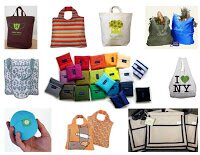
Bring Your Own Bag, especially when you shop at the grocery store…..where we tend to use many, many bags!! If you haven’t brought your own bag and you’re offered the choice between plastic and paper, choose paper. If you do bring home a plastic bag, recycle or re-use it!

… instead of paper statements, request e-statements for your bills.

When prescription or over-the-counter drugs are thrown into the garbage, or flushed down the sink or toilet, their chemical components may be added to the water supply or soil. The presence of these substances in the environment is becoming an important national and international issue. Although the concentration levels of these products in the environment may be very low, they may be enough to have adverse effects on the environment and, indirectly, on human health. Of particular concern are the potential adverse effects of cumulative, long-term exposure to trace amounts and mixtures of pharmaceuticals on vulnerable populations, including pregnant women, newborns, and children.
You can help lessen the impact of these risks by disposing of drugs in a responsible way.
- Put expired or unused pharmaceuticals in the garbage or down the toilet or sink.
- Check to see if your pharmacy has a
 drug take-back program that collects and disposes of the public’s unused and expired drugs in an environmentally safe manner. Most pharmacies do, and programs exist in many provinces and territories across the country.
drug take-back program that collects and disposes of the public’s unused and expired drugs in an environmentally safe manner. Most pharmacies do, and programs exist in many provinces and territories across the country. - If your area does not have such a program, contact your municipality to see if it collects drugs. Various municipalities have put in place different collection modes for household hazardous waste including drugs.
Tip # 21
Safe Disposal of Unwanted Paint

When painting the interior or exterior of your home, always ensure proper disposal of any remaining paint.
The information contained in this post was obtained from Squidoo.
Tip #22
Save water!!

Check out your bathroom and consider using low-flow faucets, shower heads and toilets. Do you currently use low flow fixtures?
Tip # 23
Education is the key!!
Teach your children about environmental responsibility.

The cold and frozen foods help maintain the internal temperature of the appliance.
I feel I’ve reached a bit of a “green tips” milestone, with this being week number 25. So, in honour of this, I’m offering a green tip in a little different format and presenting a short (1 min. 48sec.) video I found while on You Tube. It’s titled, How To Go Green and Save Some Green At the Same Time… hope you enjoy!
Tip # 26
Buy Local….
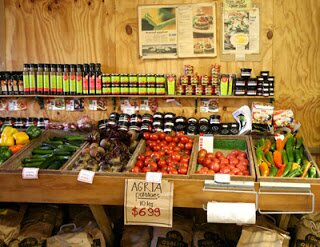
..it’s that wonderful time of the year when all the markets and roadside stands are bursting with fresh produce! Support your community growers by creating a Saturday morning family adventure by visiting your local markets, farm stands and u-picks.
In fact, in about 10 minutes, my sister and I are heading off to a local farmers market and then on to a market called “Harvesting the Arts”. Should be a fun day!!
Do you like to shop at local farmers markets?
Tip # 27
Install a clothesline



Yes, it’s been used for thousands of years, the good old solar powered clothes dryer!! Not only does it save us money, it cuts down on CO2 use as well!
Tip # 28
When cleaning, use products readily found in most homes and consider making your own cleaning solutions.

Check out this great website for more information!!
Tip #29
Strive for a litter free lunch!

OR
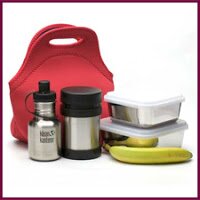
When packing a lunch for yourself or your family, strive to make it litter free.
Use reusable containers for your sandwich, leftovers, fruit or snack. (An added bonus of a rigid container is it protects the contents…no more squished sandwiches)
- Use a reusable drink container.
- Tuck in a reusable fork and spoon, wrapped in a cloth napkin
- Carry it all in a reusable bag.
- Check out this great website for more tips and the financial gain associated with a garbage free lunch.
Remember the 3-R’s
- Reduce
- Reuse
- Recycle
Tip # 30


- Do you make your costumes from “recycled” items?
- As a child, what were you dressed as for Halloween?
- If you would like to share some ideas for recycled or green costumes, I’ll post them here -
~ Pondside - “…I remember wanting to be a Fortune Teller over and over again – probably because of the bright red lipstick and the hoop earrings!”
~ SuperMomWannabe - “….My 13 yr old is making a robot costume..and we’re piecing others together, witch, can-can dancer, zombie…with minimal items to pick up (mainly make up). I really wanted one of them to use balloons and cellophane to be a bag-o-jellybeans…”
~ Patricia - “I remember making a costume out of cardboard covered with tinfoil and … voila-the Tin Man...”
~ I‘m NOT a VOLCANO! – “…Once, I was a pig- my mom took pink sweats and sewed baby bottle nipples down the front and I had a pig mask. Once, I was a mummy- white sweats and my dad safety pinned strips of muslin all over the things. Once, I was a bat, and we cut out black wings from black fabric and safety pinned them to a black hoodie.
~ Kathy – “…One Halloween I dressed one of my girls as a nurse using a home make white cardboard cap, a cape and a white dress, another as a doll in a funny short dress with pigtails and lots of face make up, and one as an angel using a flower girls dress and home made wings…”
~ My Painted Porch – “…on occasion, we were lucky enough to have a plastic mask but the rest was left up to us to find in my mom’s funky closet collection (she throws nothing out!) and a whole lot of creativity.”
~ Mom Does Reviews – “…My son made a unique combo costume this year from some of his old ones…”
~ Tammy - “For my daughters Medusa costume I re-used things I had around the house including the toy snakes for her hair. For my son’s angry bird costume I had to by some material, but I used old pillows for the stuffing for it…”
~ Michelle – “I remember possibly being a hobo. My mom sewed a ballerina costume for me once…”
Tip # 32
- Many communities now have curbside compost pick-up, so drop your pumpkin into the compost bin.
- If you have your own backyard compost,chop it up and put it in there. (Minus the seeds, which can be cleaned, seasoned, baked and snacked on)
- Or, you could do what I did….
Much of the information contained in this post was obtained from Carbon Diet

- When cooking in a pot, maximize efficiency by always using a lid.
- You can also turn off the oven several minutes before the cooking is done as the oven will retain the heat (I wouldn’t do this with sensitive baking)
- When using your oven to cook a roast, a chicken, meatloaf etc. save turning on the cook top elements by also using the heat already in the oven to bake potatoes and some vegetables
- In the cooler months, when I finish with the oven and have turned it off, I open the oven door to let the heat into the house. Why waste the oven heat?

- Lower your thermostat by 4-5 degrees Celsius (7-9 degrees Fahrenheit) while you’re sleeping at night and when no one is at home.
- Install a programmable thermostat. You can save 2% on your heating bill for every degree Celsius you turn down your thermostat.
Tip # 36Real versus Artificial(Christmas trees people…I’m talking about Christmas trees!!) For many years I felt guilty buying a real tree. I was, in essence, killing a living thing and depleting a much needed natural resource. Deep down I knew most, if not all, tree growers practised a one out, one in system to ensure a constant supply of trees, but, I was still racked with guilt.Every Dec 26th as I drove by the abandoned tree lots, as I gazed upon the unwanted and unloved carcasses left lying in the snow…I had to cover my ears in an attempt to drown out their mournful cries.
For many years I felt guilty buying a real tree. I was, in essence, killing a living thing and depleting a much needed natural resource. Deep down I knew most, if not all, tree growers practised a one out, one in system to ensure a constant supply of trees, but, I was still racked with guilt.Every Dec 26th as I drove by the abandoned tree lots, as I gazed upon the unwanted and unloved carcasses left lying in the snow…I had to cover my ears in an attempt to drown out their mournful cries. Apparently however, instead of feelings of guilt I should have been experiencing pride for making the environmentally correct choice…who knew??Until I started researching this “ethical dilemma” of mine, I was beginning to lean toward an artificial tree. After all, they are re-used every year and don’t generate the waste of their “real” cousins.However, what I didn’t realize was artificial trees are made with polyvinyl chloride (PVC), one of the most environmentally offensive forms of non-renewable, petroleum derived plastic. Also, during the production phase of PVC, several known carcinogens, including dioxin, ethylene dichloride and vinyl chloride are generated.While there seems to be, for many, no definitive answer to the real versus fake question, it is clear that many environmentalists feel real trees are the better choice.In the most comprehensive study of the perennial real vs. fake question, an environmental consulting firm in Montreal found that an artificial tree would have to be reused for more than 20 years to be greener than buying a fresh-cut tree annually. The calculations included greenhouse gas emissions, use of resources and human health impacts.“The natural tree is a better option,” said Jean-Sebastien Trudel, founder of the firm, Ellipsos, which released the independent study last year.With all of that being said I guess the most eco-friendly option is to have no tree or to purchase a live tree with its roots intact from a local grower and then replant it in your yard when Christmas is over. (For those of us that have cold winters, better dig that hole before the frost is four feet deep.)We’ve always had a real tree and I can’t see that changing in the near future.What about you… real or fake?Much of the factual information contained in this post was accessed from the following websites:http://environment.about.com/od/greenchristmas/a/christmas_trees.htmhttp://www.nytimes.com/2010/12/18/business/energy-environment/18tree.htmlTip # 37
Apparently however, instead of feelings of guilt I should have been experiencing pride for making the environmentally correct choice…who knew??Until I started researching this “ethical dilemma” of mine, I was beginning to lean toward an artificial tree. After all, they are re-used every year and don’t generate the waste of their “real” cousins.However, what I didn’t realize was artificial trees are made with polyvinyl chloride (PVC), one of the most environmentally offensive forms of non-renewable, petroleum derived plastic. Also, during the production phase of PVC, several known carcinogens, including dioxin, ethylene dichloride and vinyl chloride are generated.While there seems to be, for many, no definitive answer to the real versus fake question, it is clear that many environmentalists feel real trees are the better choice.In the most comprehensive study of the perennial real vs. fake question, an environmental consulting firm in Montreal found that an artificial tree would have to be reused for more than 20 years to be greener than buying a fresh-cut tree annually. The calculations included greenhouse gas emissions, use of resources and human health impacts.“The natural tree is a better option,” said Jean-Sebastien Trudel, founder of the firm, Ellipsos, which released the independent study last year.With all of that being said I guess the most eco-friendly option is to have no tree or to purchase a live tree with its roots intact from a local grower and then replant it in your yard when Christmas is over. (For those of us that have cold winters, better dig that hole before the frost is four feet deep.)We’ve always had a real tree and I can’t see that changing in the near future.What about you… real or fake?Much of the factual information contained in this post was accessed from the following websites:http://environment.about.com/od/greenchristmas/a/christmas_trees.htmhttp://www.nytimes.com/2010/12/18/business/energy-environment/18tree.htmlTip # 37
Reuse/Recycle/Re-purpose your old Christmas cards! I met my sisters this morning for an outing to our local market. During the course of the morning the discussion of old Christmas cards came up.They were both telling me about re-purposing their old cards by cutting out interesting features, such as a snowman, tree, santa, angel, etc. Using a hole punch to make a small opening in the “tag”, threading some pretty ribbon or twine through the opening and voilà… beautiful gift tags!
I met my sisters this morning for an outing to our local market. During the course of the morning the discussion of old Christmas cards came up.They were both telling me about re-purposing their old cards by cutting out interesting features, such as a snowman, tree, santa, angel, etc. Using a hole punch to make a small opening in the “tag”, threading some pretty ribbon or twine through the opening and voilà… beautiful gift tags! PHOTO FROM GOOGLE FILESI had forgotten, but our Mom always did this too, what a brilliant idea, she was way ahead of her time!!Tip # 38It may be the most wonderful time of the year but it’s also the most wasteful! Save energy by choosing LED lights for your Christmas tree.
PHOTO FROM GOOGLE FILESI had forgotten, but our Mom always did this too, what a brilliant idea, she was way ahead of her time!!Tip # 38It may be the most wonderful time of the year but it’s also the most wasteful! Save energy by choosing LED lights for your Christmas tree. Choose LEDs (light-emitting diodes) instead of incandescent bulbs to decorate your tree and home. They’re more expensive, but last much longer and use 80% to 90% less power than conventional mini bulbs. LEDs, which cast a bright white light, also stay cool to the touch so they won’t singe the tree—or your child’s fingers.The information contained in this post was found at Time Magazine BusinessTIP # 39WHAT TO DO WITH ALL THAT WRAPPING PAPER???
Choose LEDs (light-emitting diodes) instead of incandescent bulbs to decorate your tree and home. They’re more expensive, but last much longer and use 80% to 90% less power than conventional mini bulbs. LEDs, which cast a bright white light, also stay cool to the touch so they won’t singe the tree—or your child’s fingers.The information contained in this post was found at Time Magazine BusinessTIP # 39WHAT TO DO WITH ALL THAT WRAPPING PAPER???
- You can carefully remove it and then reuse it…let’s face it; this probably won’t be happening on Christmas morning!!
- Unless it’s the kind that has foil or some kind of waxy lining, most paper, including wrapping paper and tissue paper, is recyclable
- If it is not glossy, does not have a plastic, waxy, or metallic coating, and is not shockingly bright (officially known as Astro bright), it can probably be composted safely. Generally, if it tears easily, it’s okay to compost it.
One thing you should never do with it is burn it. Burning glossy or waxy paper, especially if it is brightly coloured or has a metallic finish, can release highly toxic chemicals into the air.Below is a quick reference chart -
|
PAPER TYPE
|
REUSE
|
RECYCLE
|
COMPOST
|
GARBAGE
|
|
Glossy
|
X
|
X
|
||
|
Metallic
|
X
|
X
|
||
|
Wax-Coated
|
X
|
X
|
||
|
Plain/Non-Glossy, Non-AstroBright
|
X
|
X
|
X
|
|
|
Tissue
|
X
|
X
|
X
|
|
|
Paper Tube
|
X
|
X
|
X
|
|
|
Paper Boxes
|
X
|
X
|
(some)
|
I referenced the following site for the information contained in this post -http://ccetompkins.org/energy/heating-wood/what-do-wrapping-paperTip # 40Get Back to the Basics
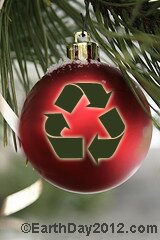
Let’s all try to be a little greener in 2012 and get back to the basics by remembering the three “R’s”:
- Reduce
- Reuse
- Recycle
We all need to remember that we are stewards of this planet, if we don’t protect it for future generations, who will?Wishing everyone a happy, healthy and green 2012!
Tip # 41
Avoid idling your vehicle for more than one minute
Tip # 42
Caulking


- To make sure caulking sticks well, clean the surface area thoroughly first and allow it to dry before you caulk.
- The cost of improving the airtightness of your home through caulking is low compared with the subsequent fuel savings and increased comfort.
- Silicone caulking is ideal for metal, glass, glazed tile and plastic surfaces because it sticks, flexes and does not shrink over time.
- Acrylic latex caulking is a general-purpose sealant that sticks best to porous materials like wood and concrete.
- All-purpose caulking is good for both interior and exterior use, including bathrooms and kitchens.
- Polyurethane caulking performs well on both porous and non-porous surfaces, is flexible, paintable, long-lasting and hard as nails.
- A heat-resistant caulking should be used around sources of heat, such as chimneys, light fixtures and fan motors.
- Caulking should be used for its intended purpose only. For example, an exterior sealant can be a health hazard if used indoors.
Tip # 43 Maintain your vehicle

Keeping your vehicle in top shape will save fuel and help the environment.
- Keep tires inflated: Just one tire under inflated by six psi can increase fuel consumption by three per cent and wear up to 40 per cent faster.
- Replace the plastic cap on the tire’s air valve with a steel cap, which seals much better than the standard issue cap. This is the best tool to keep your tires inflated and generally costs less than one dollar.
- Align tires: A misaligned tire will use around two per cent more fuel and cause premature tire wear.
- Use appropriate fuel: Read your owner’s manual before heading to the pumps and use the recommended type of fuel. Using supreme or premium fuels in cars designed for regular fuel is paying a premium price for something that will not work as well. It is a waste of money and fuel, could hurt the engine, and will harm the environment.
Keep tank full in winter: Keeping your gas tank full can end up saving you big. When the gas tank isn’t full, the moist air in the gas tank condenses against the inside wall of the tank. This water affects the quality of the fuel, causing starting problems, fuel not being burned efficiently, engine misfiring, and adding strain to the engine.
Tip # 44Lights out!
 It’s obvious, but turning off lights at night can save you, and the environment, big. A computer left on to run 24 hours a day can increase the electricity bill by $75 to $120 yearly. By putting the computer into standby mode, this amount is reduced to only $15 per year.Tip # 45
It’s obvious, but turning off lights at night can save you, and the environment, big. A computer left on to run 24 hours a day can increase the electricity bill by $75 to $120 yearly. By putting the computer into standby mode, this amount is reduced to only $15 per year.Tip # 45
Why should we care about a little thing like plastic bags?


- Plastic bags are made from oil, a non-renewable resource that contributes to global warming. The energy used to produce all the plastic bags that a typical household goes through in a year is enough to light that same house for six full months.
- When tossed away, it takes between 450 and 1,000 years for plastic bags to break down in a landfill. But plastic never really does degrade completely. It ends up as “plastic dust”, lining our landfills and swallowed up by marine animals.
- If incinerated, they release harmful toxins such heavy metals (aluminum, lead, chromium, zinc, nickel) and polycyclic aromatic hydrocarbons (PAHs) which pose a danger to our health. Please! Consider using cloth, reusable or paper before choosing to use plastic.
 We’re coming into the season where we’re sorting through everything “summer” and if you’ve come across an old garden hose that no longer can serve it’s original purpose…here are some great tips for reusing it!
We’re coming into the season where we’re sorting through everything “summer” and if you’ve come across an old garden hose that no longer can serve it’s original purpose…here are some great tips for reusing it!
- Make a slit in a length and use sections as beading to cover sharp surfaces. (such as the edges of metal or steel)
- As padding for wire bucket handles (my personal favourite use!)
- By sealing off one end and making a series of very small holes in the hose, you can turn a standard garden hose into a soaker hose.
- If you have trees staked, run a section of hose over the rope/string/whatever to protect the trunk of the tree.
 Plant selection – purchase plants that are native to or known to thrive in your region without a lot of additional watering.
Plant selection – purchase plants that are native to or known to thrive in your region without a lot of additional watering.- Sprinklers – many sprinklers throw out a fine, high, spray of water which is often gone via wind and evaporation before it even reach the garden. Look to buy a sprinkler that throws water closer to the ground in large drops.
- Drip irrigation – This can save you a ton of water. (See tip #46, Repurposing your old garden hose}
- Irrigation timers – If you use an irrigation timer, set it to run half the normal time, but run it a second cycle a minimum of half an hour later. This will dramatically reduce run off.
- Watering time – The best time of the day to water is either just around sunrise or just around sunset, as this minimizes water evaporation.
- Mulch – Mulching is one of the most effective ways to reduce water needed in a garden – up to 50%.
- Aerate your lawn and garden – An aerator pulls out small plugs of soil allowing air and water to penetrate deeper. Deeper moisture means deeper root systems; which makes plants more resistant to dry spells and requiring less water.
- Consider a rainwater tank – Given the amount of water gardens require; consider adding a rainwater catchment system to your property. There’are all sorts of rain water tanks and barrels available to suit your premises, ranging from holding a few dozen gallons, to thousands.

Whether you’re like me and drink gallons a day or you just brew up a cup or two…I have some great environmentally friendly uses for all those used grounds.
- Use coffee grounds as a plant fertilizer. Sprinkle the grounds around the base of the plant then dig them in a little. They can also be sprinkled directly on your lawn. {I will definitely be doing this}
- Add the grounds to compost piles to enrich nutrient content – the grounds contain Nitrogen, Phosphorus, Potassium, Calcium, Magnesium and Sulfur. Phosphorous is becoming scarce, so we need to conserve it as much as possible. {We already do this}
- Add water to the grounds and allow to stand for a day or two. Drain off and then use as a liquid plant fertilizer – cold coffee that you’d usually toss down the sink can also be used in this way. {it’s gardening time here so I’m going to try this.}
- After drying the grounds thoroughly, put them in a small open container and use in cupboards and your refrigerator as an odour absorber. {I didn’t realize coffee had this absorbent quality, definitely worth trying}
- Rubbing your hands with used coffee grounds will remove strong smells such as onion or fish. {Good tip, I’ve heard of using lemon, but never coffee. I’m going to try this one too}
- Grounds can be used as a scourer for greasy pots and pans. {I’ve actually done this on non-stick pans and it worked well as a slight abrasive}
- A ring of coffee grounds around sensitive plants can discourage ants and some other pests. {We do have a fair amount of ants, so I’m going to try this…wonder if it will repel deer??? lol}
- Use as a wood stain. Allow them to soak in a small amount of water overnight (or hot water for a shorter period), then drain off. The amount of water you use will determine how dark the stain is. Also good for touch-ups to mahogany furniture. {We actually have a small scratch on our dining room table so I’m going to try this}
- If you have a worm farm, dump the grounds in – apparently they love them! {I don’t have a worm farm but apparently worms and I have a common love for coffee!}
Much of the information contained in this post was obtained from Green Living Tips.
- Photo credit – flourishmag.com
I found a great article at Green Living Tips, outlining 24 Uses for Lemons. I’ve included a few of them below; be sure to read the complete article for even more great uses for lemons!
 Ant deterrent -Pouring lemon juice around areas that ants frequent is said to repel them.
Ant deterrent -Pouring lemon juice around areas that ants frequent is said to repel them.
 When preparing for your picnic or backyard barbecue, think, reuseable tableware. If that isn’t an option, use compostable plates, cups and bowls (not styrofoam) with reuseable utensils.It would be somewhat ironic to celebrate this wonderful country and all it has to offer, while at the same time, contributing to our earth’s demise.#52Toilet Tissue rolls in your garden?
When preparing for your picnic or backyard barbecue, think, reuseable tableware. If that isn’t an option, use compostable plates, cups and bowls (not styrofoam) with reuseable utensils.It would be somewhat ironic to celebrate this wonderful country and all it has to offer, while at the same time, contributing to our earth’s demise.#52Toilet Tissue rolls in your garden? This tip may be a little late for this years gardens but it was so great I wanted to share it with you. Be sure to keep it in mind for next spring.To make your own biodegradable mini-planter (that’s right, no transplanting!), you will need scissors and a toilet paper or paper towel roll.
This tip may be a little late for this years gardens but it was so great I wanted to share it with you. Be sure to keep it in mind for next spring.To make your own biodegradable mini-planter (that’s right, no transplanting!), you will need scissors and a toilet paper or paper towel roll.
How to make it:
1. Using scissors, cut six to eight small slits in the end of your toilet paper roll (if using a paper towel roll, cut the roll into three pieces before beginning this step).2. Fold the strips down so they overlap.3. Fill carefully with wet soil, and set in a baking sheet.4. Plant one seed per roll. After germination, just plant the whole thing in your garden!If you don’t mind transplanting your seedlings, you can use all kinds of recyclables for germination: Takeout containers, plastic cups, soda bottles and shoe boxes – just to name a few.The information in this post was obtained from Earth 911.Tip # 53Make some popsicle stick garden markers!The hot, humid days of summer mean we’re all eating icy treats to help stay cool. You could definitely compost those wooden sticks, but better still, why not save those sticks for reuse in your garden and then compost them down the road. 

To use your throw-aways to make customized markers for your garden or seedlings, you’ll need Popsicle sticks, a permanent marker and a reusable cloth.
How to make it:
1. Apply a few drops of rubbing alcohol or a solution of warm water and sea salt to the ends of your ice pop sticks. Use the reusable cloth to rub off any remaining stickiness.2. Let the sticks dry in the sun for at least an hour.3. Label your sticks with permanent marker, and use them to mark crops in your herb garden or veggie plot.If you’re feeling ambitious, you can also make your own customized garden markers from old milk jugs using this simple tutorial from TLC.Information contained in this post was obtained from Earth 911Tip # 54Make a simple self-irrigating water systemAre you like me and keep forgetting to water your container vegetables, herbs and flowers? I also hate when the water runs over the top and out the bottom…what a waste of water! Well, I found this simple solution online at Earth911.com. It’s a simple to set up, self irrigation system that will save you time and water.Sounds tricky, right? It actually couldn’t be easier. All you’ll need is scissors, a plastic bottle (great way to reuse plastic and when you’re finished with it, you can still throw it in the recycling bin!), a hand shovel and about five minutes to get the job done.
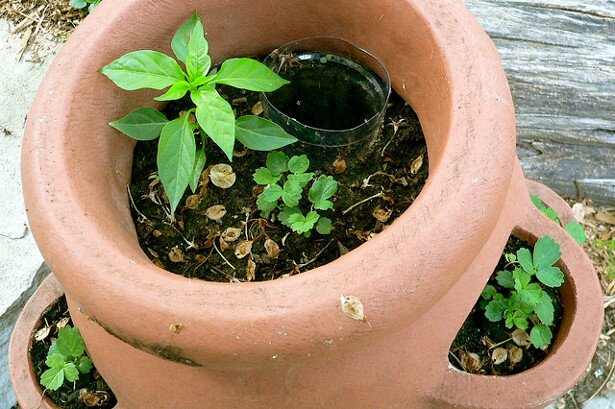
- Image is from the Earth911.com website.
How to make it:1. Using scissors, carefully cut the bottom out of your plastic bottle. Remove bottle cap and set aside for recycling.2. Use a hand shovel to dig a 6-inch-deep hole in the potted plant of your choice, as far away from the plant as possible to avoid damaging roots.3. Place your plastic bottle in the hole, bottleneck end down. Use your hands to pack soil around the bottle so it stands upright.4. Fill the bottle with water as needed, and watch it slowly seep into the soil – saving you time and nurturing your thirsty plants.Information contained in this post was obtained from Earth911.com, drop by and check out there website fore more awesome Earth friendly tips.Tip # 55Recycle collected dehumidifier water! We have a dehumidifier and during the summer months we empty the collection reservoir of several litres of water daily. Instead of dumping it down the drain, we use the water to water the garden and potted plants.My sister over at Oak Lawn Images and Myotonic Dystrophy – Our Family’s Journey, dumps the collected water from her dehumidifier into her washer. When she needs to do laundry she already has a good start on filling the washer tub.What do you do with the water collected by your dehumidifier? Have any good tips? I’ll post them here.
We have a dehumidifier and during the summer months we empty the collection reservoir of several litres of water daily. Instead of dumping it down the drain, we use the water to water the garden and potted plants.My sister over at Oak Lawn Images and Myotonic Dystrophy – Our Family’s Journey, dumps the collected water from her dehumidifier into her washer. When she needs to do laundry she already has a good start on filling the washer tub.What do you do with the water collected by your dehumidifier? Have any good tips? I’ll post them here.
Tip # 56
Green plants help to recycle and freshen the air you breath all winter long. Once your home is sealed, you need the plants to help remove toxins and stale air. You will feel better emotionally and physically with the addition of living plants in your home.Information in this post was obtained from Greener Ideal.
-

- The water coming into your home is colder this time of year taking more energy to heat.
- If your water heater is stored in a cooler area of your home that result in even additional energy to heat the water.
- Once the water is warm, it will also cool down faster during the winter months.




